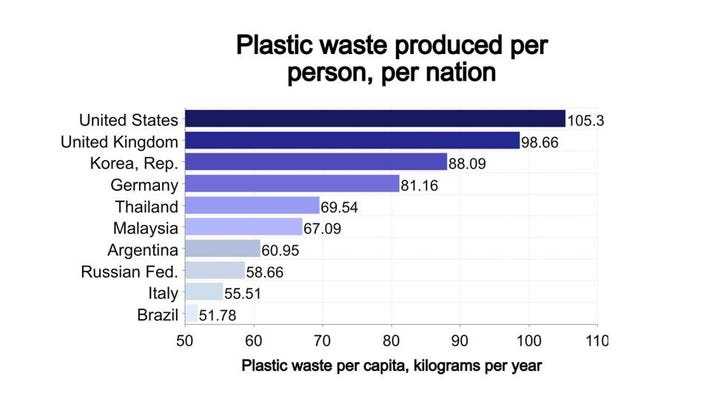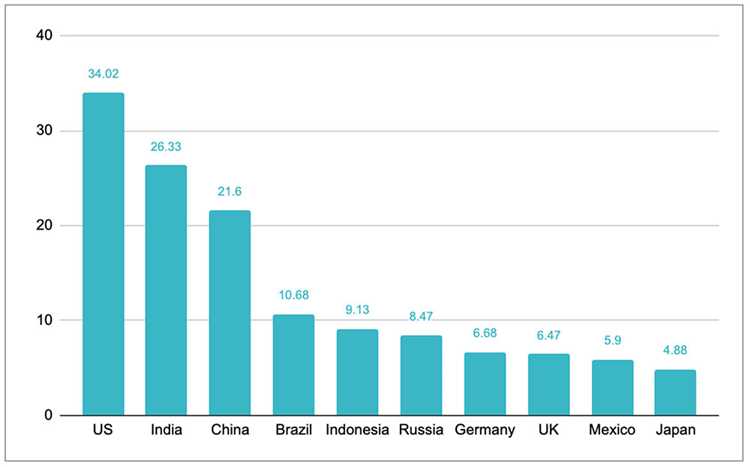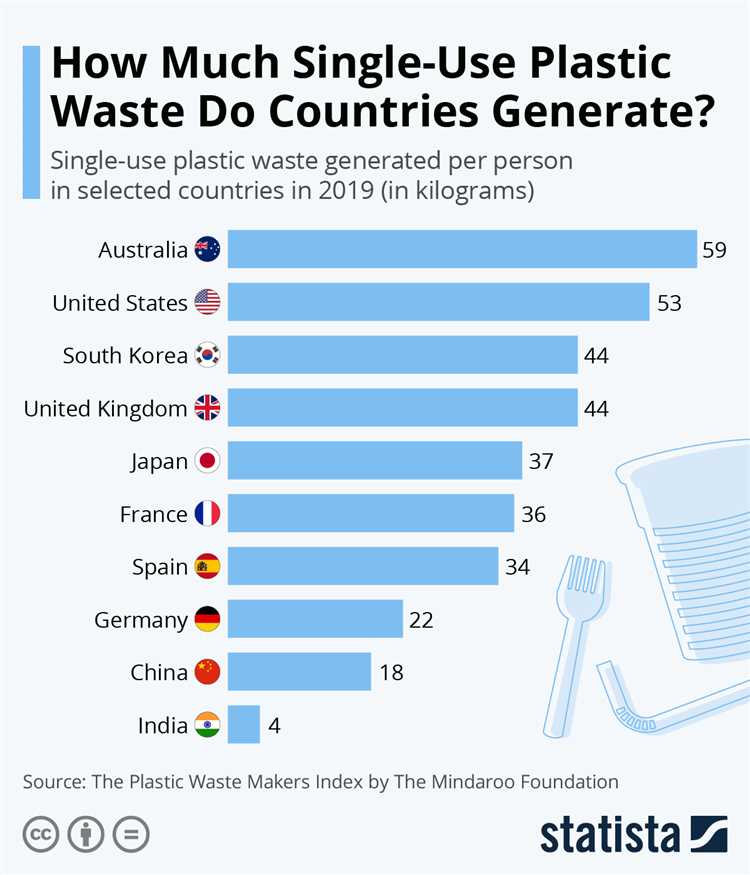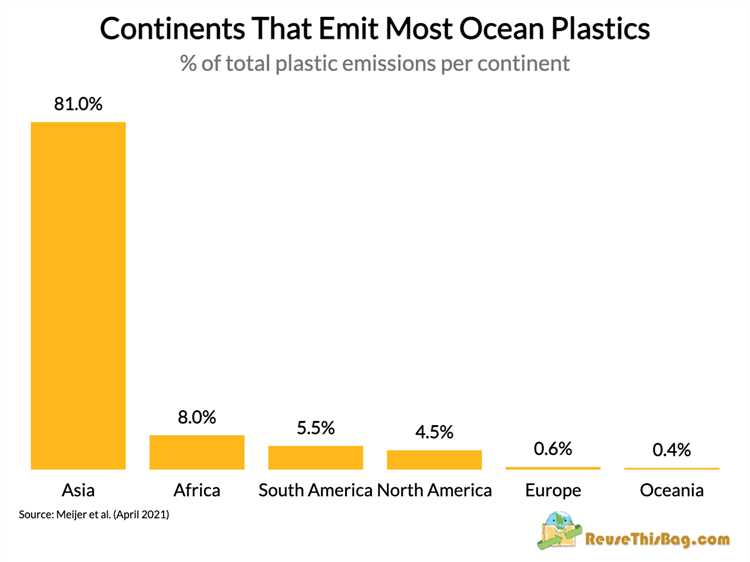
Plastic pollution has become a pressing issue worldwide, with devastating effects on the environment and marine life. It is estimated that more than 8 million metric tons of plastic end up in the oceans every year, causing irreversible damage. While plastic pollution is a global problem, some countries contribute more to this crisis than others.
According to recent studies and research, one country that currently tops the list for plastic pollution is China. Being the most populous country in the world, it generates a massive amount of plastic waste. Furthermore, China has been a major producer and exporter of plastic products, leading to a significant increase in plastic consumption and waste production.
Another reason why China is a major contributor to plastic pollution is its inadequate waste management infrastructure. The country faces challenges in recycling and proper disposal of plastic waste, resulting in a significant amount of plastic ending up in rivers and oceans. Despite efforts to improve waste management systems, China still has a long way to go in reducing its plastic pollution levels.
- The Global Impact of Plastic Pollution
- The Rank of Countries
- Effects on Marine Life
- 1. Entanglement
- 2. Ingestion
- 3. Chemical Contamination
- 4. Habitat Destruction
- Land and Air Pollution
- Health Risks for Humans
- Initiatives to Combat Plastic Pollution
- Future Outlook
- Innovation and Research
- Education and Awareness
- Q&A:
- Which country tops the list for plastic pollution?
- What are the main contributors to plastic pollution in China?
- How does plastic pollution affect marine life?
- What are some initiatives being taken to address plastic pollution in China?
- Is plastic pollution a global problem or is it specific to certain countries?
- What country is the biggest contributor to plastic pollution?
The Global Impact of Plastic Pollution
Plastic pollution is a worldwide environmental crisis that is having a significantly negative impact on the planet. The proliferation of plastic waste has become a major concern due to its harmful effects on ecosystems, wildlife, and human health.
One of the main problems with plastic pollution is its durability. Plastics can take hundreds of years to break down, leading to the accumulation of waste in landfills, oceans, and other natural environments. This not only poses a visual and aesthetic problem, but it also has serious consequences for wildlife.
Marine animals are particularly vulnerable to plastic pollution. Many sea creatures mistake plastic debris for food and end up consuming it, leading to internal injuries, digestive problems, and even death. This has devastating consequences for marine ecosystems and the delicate balance of life in the oceans.
Plastic pollution also has significant economic implications. Tourism, fishing, and other industries that rely on clean and healthy environments are negatively affected by plastic pollution. The cost of cleaning up plastic waste and the damage it causes is a burden on governments and taxpayers.
Furthermore, plastic pollution has a direct impact on human health. Microplastics, tiny particles of plastic that result from the breakdown of larger plastic items, have been found in drinking water, seafood, and other food sources. There is growing concern about the potential health risks associated with the ingestion of these microplastics.
In order to address the global impact of plastic pollution, it is essential for countries around the world to take action. This includes implementing policies to reduce plastic production, promoting recycling and waste management programs, and developing alternatives to single-use plastics.
By working together, we can mitigate the global impact of plastic pollution and ensure a healthier and more sustainable planet for future generations.
The Rank of Countries

When it comes to plastic pollution, some countries stand out as major contributors to the global crisis. Here is a ranking of countries based on their plastic pollution levels:
| Rank | Country | Plastic Pollution Index |
|---|---|---|
| 1 | China | 72.0 |
| 2 | Indonesia | 39.8 |
| 3 | Philippines | 35.7 |
| 4 | Vietnam | 35.3 |
| 5 | Sri Lanka | 35.0 |
It is important to note that these rankings are based on various factors such as plastic waste generation, population size, and waste management practices. While these countries top the list, plastic pollution is a global issue that requires collective efforts to address.
Effects on Marine Life
Plastic pollution has a devastating impact on marine life. The vast amounts of plastic waste that end up in our oceans pose serious threats to various marine species and ecosystems. Here are some effects of plastic pollution on marine life:
1. Entanglement
Marine animals such as turtles, dolphins, and sea birds often mistake plastic debris for food or get entangled in plastic waste. This can lead to severe injuries, suffocation, and even death. Fishing nets, plastic bags, and six-pack rings are particularly hazardous, as they can entangle marine animals and restrict their movement or ability to feed.
2. Ingestion
Plastic fragments in the ocean resemble food particles and are commonly eaten by marine animals. Sea turtles, whales, and seabirds mistake plastic bags for jellyfish, and smaller sea creatures ingest microplastics, thinking they are tiny organisms. Ingesting plastic can cause internal injuries, blockages in the digestive system, and disrupt the animal’s ability to absorb nutrients, leading to malnutrition and starvation.
3. Chemical Contamination
Plastic debris in the ocean acts as a sponge for toxic chemicals. As plastic breaks down into smaller pieces, it releases harmful substances such as polychlorinated biphenyls (PCBs) and phthalates into the water. Marine animals that ingest these plastic particles are not only exposed to physical harm but also to these toxic chemicals, which can have long-term effects on their health and reproductive abilities.
4. Habitat Destruction
Plastic pollution alters marine habitats, particularly coral reefs and seagrass beds. When plastic waste accumulates on these fragile ecosystems, it blocks sunlight from reaching corals, depriving them of essential nutrients and leading to their bleaching and eventual death. Seagrass beds, crucial nursery grounds for various marine species, can also suffer from plastic pollution, reducing their ability to support marine life.
These are just a few examples of the detrimental effects of plastic pollution on marine life. Urgent actions are needed to address this global crisis and reduce the amount of plastic waste entering our oceans. Through awareness, education, and sustainable practices, we can work towards a cleaner and healthier marine environment.
Land and Air Pollution
Plastic pollution affects not only our oceans and waterways but also land and air. The improper disposal of plastic waste contributes to the contamination of soil and can have detrimental effects on the environment and human health.
When plastics are not properly disposed of and end up in landfills, they can take hundreds of years to decompose. As they break down, they release harmful chemicals into the soil, which can seep into groundwater and pollute local water sources. This contamination not only affects plants and animals but also human populations, who may rely on these water sources for drinking and irrigation.
In addition to soil pollution, plastic pollution also contributes to air pollution. When plastic waste is burned or incinerated, toxic fumes are released into the atmosphere. These fumes contain harmful chemicals, such as dioxins and furans, which can have serious health effects when inhaled. These pollutants can cause respiratory issues, cardiovascular problems, and even cancer.
The burning of plastic waste is a common practice in many countries that lack proper waste management systems. This not only contributes to air pollution but also exacerbates the plastic pollution problem, as it releases more plastic particles into the environment. This cycle of pollution further perpetuates the global plastic crisis.
Efforts to address land and air pollution caused by plastic waste include implementing proper waste management strategies, promoting recycling and composting, and reducing plastic consumption. Education and awareness campaigns are also crucial in informing the public about the impacts of plastic pollution and encouraging behavior change.
- Implement proper waste management strategies
- Promote recycling and composting
- Reduce plastic consumption
- Education and awareness campaigns
By addressing land and air pollution caused by plastic waste, we can help protect the environment, safeguard human health, and mitigate the negative impacts of plastic pollution on ecosystems worldwide.
Health Risks for Humans
Plastic pollution poses significant health risks for humans. When plastic waste enters the environment, it can break down into microplastics, tiny particles that are less than 5 millimeters in size. These microplastics can contaminate the air, water, and food that we consume.
When we breathe in air contaminated with microplastics, they can enter our respiratory system and potentially cause respiratory problems. Studies have also shown that microplastics can accumulate in our lungs, leading to inflammation and other respiratory diseases.
Microplastic contamination in water sources can also have adverse effects on human health. When we drink water that is contaminated with microplastics, they can enter our digestive system and potentially cause digestive issues. In addition, studies have found that microplastics can also pass through the gut barrier and enter the bloodstream, posing further health risks.
Furthermore, microplastics can contaminate the food chain. Marine animals, such as fish and shellfish, can ingest microplastics when they mistake them for food. When humans consume seafood contaminated with microplastics, they can be exposed to harmful chemicals and toxins that are present in the plastic particles. These chemicals can have detrimental effects on human health, including hormonal disruptions, reproductive issues, and an increased risk of certain cancers.
Overall, plastic pollution poses a serious threat to human health. The ingestion and inhalation of microplastics can lead to respiratory problems, digestive issues, and exposure to harmful chemicals. It is essential that we take action to reduce plastic waste and prevent further harm to human health.
Initiatives to Combat Plastic Pollution
Plastic pollution is a global problem that requires collaborative efforts from governments, organizations, and individuals to address. Many countries have recognized the urgency of the issue and have implemented various initiatives to combat plastic pollution. Here are some notable initiatives taken by different countries:
| Country | Initiative |
|---|---|
| India | India has introduced a ban on single-use plastics in many states and cities. They have also implemented the “Swachh Bharat Abhiyan” campaign, which aims to clean up public spaces and promote responsible waste management. |
| Canada | Canada has made commitments to ban harmful single-use plastics by 2021. They are also investing in research and development of more sustainable alternatives to plastic. |
| Rwanda | Rwanda is often lauded as a leader in plastic pollution reduction due to its strict ban on single-use plastic bags since 2008. The country has experienced significant improvements in environmental cleanliness as a result. |
| Australia | Australia has implemented the “National Plastic Plan” to reduce plastic waste by phasing out certain single-use plastics, promoting recycling and supporting research into innovative solutions. |
| Norway | Norway has introduced a plastic bottle deposit system, which encourages consumers to return plastic bottles for recycling in exchange for a small refund. This has resulted in a high recycling rate for plastic bottles in the country. |
These are just a few examples of the initiatives being undertaken worldwide to combat plastic pollution. It is encouraging to see countries taking proactive steps to protect the environment and reduce plastic waste. However, more needs to be done at a global level to effectively address the scale of the problem and ensure a sustainable future.
Future Outlook
The future outlook for plastic pollution remains concerning, as the problem continues to worsen on a global scale. The increasing production and consumption of plastic, coupled with inadequate waste management systems, have led to an unsustainable situation.
International efforts are being made to address the issue, with countries around the world implementing policies and strategies to reduce plastic pollution. Many governments have introduced bans on single-use plastics and are encouraging the use of alternative materials.
However, a collective and collaborative approach is needed to effectively tackle the problem. Cooperation between governments, industries, and the public is crucial to developing innovative solutions and implementing effective measures.
Innovation and Research

Innovation and research play a vital role in finding sustainable alternatives to plastic and improving waste management practices. Scientists and engineers are working on developing biodegradable plastics, as well as exploring new recycling technologies.
Investment in research and development is essential to drive progress in this field and find solutions that are both environmentally friendly and economically viable.
Education and Awareness

Education and awareness campaigns are essential to changing consumer and societal behavior. By educating the public about the environmental impact of plastic pollution and promoting responsible consumption and waste management practices, attitudes can shift towards a more sustainable future.
Efforts to reduce plastic pollution will require a long-term commitment and sustained actions at all levels. By working together, we can make a significant impact and create a cleaner and healthier planet for future generations.
Q&A:
Which country tops the list for plastic pollution?
The country that tops the list for plastic pollution is China.
What are the main contributors to plastic pollution in China?
The main contributors to plastic pollution in China are the excessive production and consumption of single-use plastics, poor waste management practices, and the lack of awareness about the environmental impact of plastic waste.
How does plastic pollution affect marine life?
Plastic pollution has a devastating impact on marine life. Marine animals often mistake plastic debris for food, which can lead to ingestion and entanglement, causing injury or death. It also disrupts the entire marine ecosystem and can have long-term effects on biodiversity.
What are some initiatives being taken to address plastic pollution in China?
China has implemented various initiatives to address plastic pollution, such as banning single-use plastics in certain areas, promoting recycling and waste management programs, and raising awareness through educational campaigns. Additionally, the government is encouraging the development of alternative materials and technologies to reduce plastic waste.
Is plastic pollution a global problem or is it specific to certain countries?
Plastic pollution is a global problem that affects all countries. While some countries may contribute more to the issue due to factors like high population, industrial production, or inadequate waste management infrastructure, the problem of plastic pollution requires international cooperation and collective efforts to find sustainable solutions.
What country is the biggest contributor to plastic pollution?
The biggest contributor to plastic pollution is China. They produce the largest quantity of plastic waste globally.